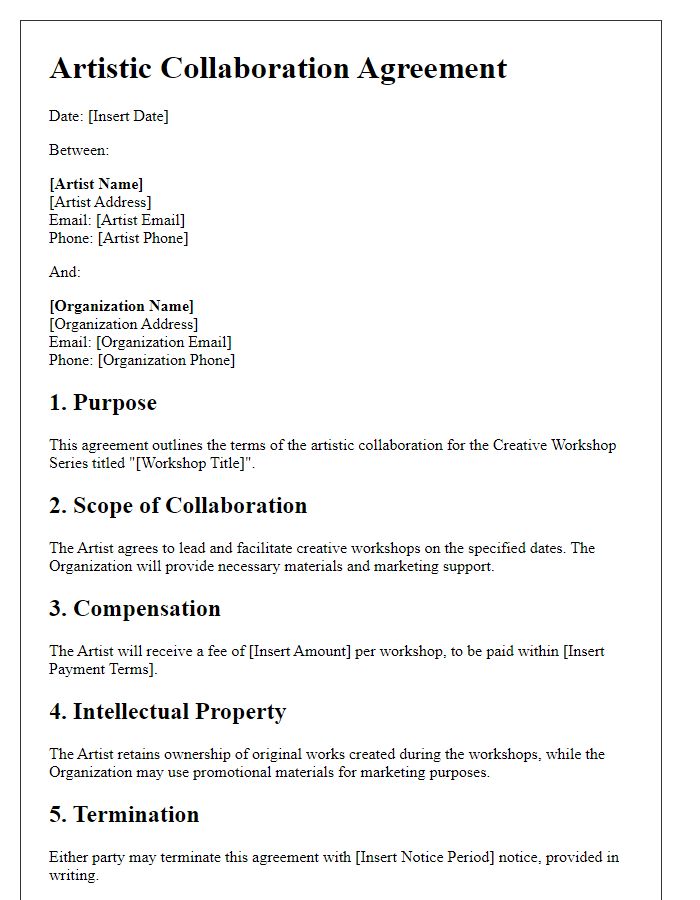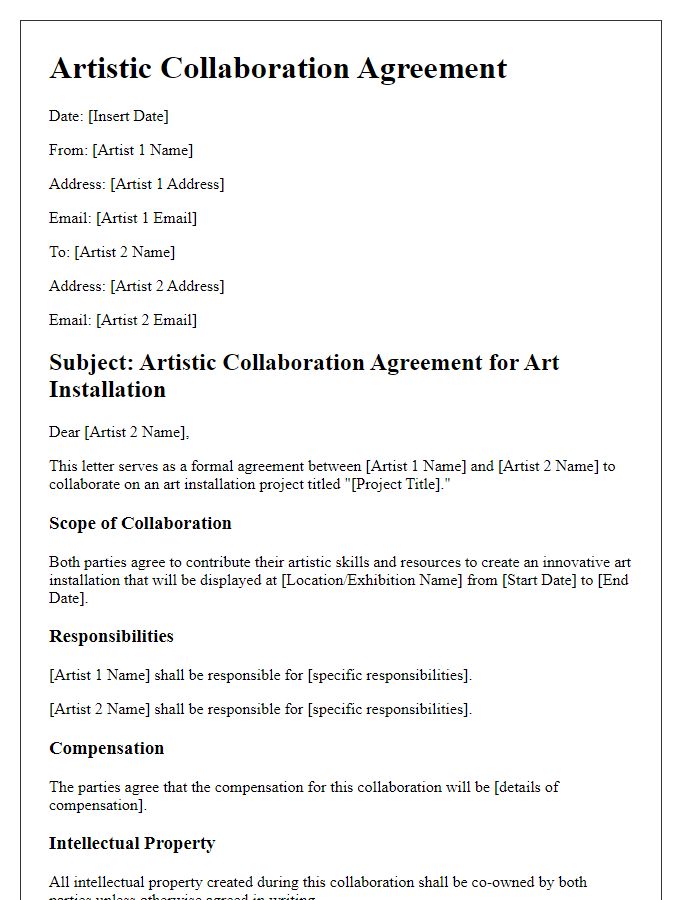Are you an artist looking to collaborate on an exciting project? It's essential to have a clear agreement in place to ensure both parties share a mutual understanding of responsibilities, timelines, and creative contributions. This letter template serves as a helpful guide to formalize your artistic collaboration while protecting your rights and ideas. Keep reading to explore how to craft the perfect collaboration agreement that inspires creativity and fosters a productive partnership!

Clearly defined roles and responsibilities
An artistic collaboration agreement outlines the clear roles and responsibilities of each participant involved in the project. Defined roles establish specific tasks for creators, such as visual artists, writers, and musicians, to harmonize their efforts efficiently. Responsibilities include deadlines for artwork delivery, contribution of creative concepts, and marketing strategies for promotional activities. Clarity in each contributor's involvement ensures accountability, fostering a productive environment. Additionally, inclusion of compensation terms, intellectual property rights, and dispute resolution mechanisms further solidifies expectations and collaboration dynamics throughout the creative process.
Intellectual property rights and usage
An artistic collaboration agreement outlines essential terms regarding the ownership of intellectual property (IP) created during the partnership. Each artist contributes unique elements, emphasizing the need for clarity on IP rights, including copyrights and trademarks. For instance, if two visual artists from New York City collaborate on a mural project, they must specify which party retains rights to the artwork, including future reproduction and distribution. The agreement should also define terms for usage, such as whether one artist can sell prints or merchandise derived from the collaborative work without consent from the other. Additionally, it is crucial to establish a process for resolving disputes related to IP use, ensuring both parties understand rights to modify or adapt the work. Such documentation fosters a positive creative environment and protects the contributions of each artist involved in the collaboration.
Payment terms and compensation
An artistic collaboration agreement outlines payment terms and compensation details to ensure mutual understanding between collaborating artists. Compensation might include monetary payments, equity shares in a project, or in-kind exchanges such as co-creation credits or future project opportunities. Specific payment milestones, such as an initial deposit before work begins, partial payments upon completion of predefined stages, and final balance upon project delivery, should be clearly stated. Additionally, any profit-sharing percentages or royalty agreements should be specified, detailing how revenues from sales, performances, or exhibitions will be divided among the collaborators. The agreement should also cover reimbursement for any pre-approved expenses incurred during the collaboration, ensuring transparency in financial arrangements.
Confidentiality and non-disclosure agreements
An artistic collaboration agreement often encompasses confidentiality and non-disclosure clauses to protect the creative ideas, concepts, and shared materials exchanged between collaborators. These agreements typically outline specific terms regarding the handling of intellectual property (ideas or works created collaboratively), stipulating that all sensitive information--including sketches, prototypes, scripts, and business strategies--remain confidential. Parties involved in the collaboration, such as visual artists, musicians, or writers, agree not to disclose any proprietary information to outside parties without prior consent. The agreement may specify the timeframe during which confidentiality must be maintained, often extending beyond the duration of the collaboration. Violation of these terms can lead to legal consequences, emphasizing the importance of trust and integrity in artistic partnerships.
Termination and dispute resolution policies
Artistic collaboration agreements often require clear termination and dispute resolution policies to ensure that all parties understand their rights and obligations in the event of disagreements. Each collaboration may specify a defined notice period, typically 30 days, for termination to allow for the resolution of issues. Dispute resolution methods, such as mediation or arbitration, can be outlined, specifying a neutral location and a professional mediator's qualifications. For example, if the collaboration takes place in New York City, the agreement may designate the American Arbitration Association as the governing body for arbitration procedures. Jurisdiction and applicable law should be clarified, typically citing the state or region where the collaboration occurs, like California law governing a partnership in Los Angeles. By including these provisions, artists can navigate conflicts with a structured approach, emphasizing clear communication and collaboration.
Letter Template For Artistic Collaboration Agreement Samples
Letter template of Artistic Collaboration Agreement for Exhibition Participation.

Letter template of Artistic Collaboration Agreement for Performance Partnership.

Letter template of Artistic Collaboration Agreement for Co-Creation Initiative.

Letter template of Artistic Collaboration Agreement for Funded Artistic Endeavor.

Letter template of Artistic Collaboration Agreement for Creative Workshop Series.

Letter template of Artistic Collaboration Agreement for Art Installation Collaboration.

Letter template of Artistic Collaboration Agreement for Multimedia Project.

Letter template of Artistic Collaboration Agreement for Research and Development.






Comments